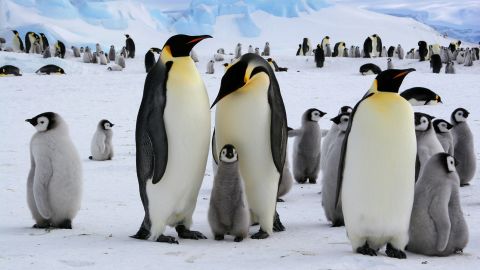
As Antarctica’s emperor penguins are increasingly threatened by the climate crisis, the flightless seabirds will receive new protections under the Endangered Species Act, or ESA.
With global warming melting the sea ice the penguins depend on for their survival, the US Fish and Wildlife Service now categorizes the species as threatened. The federal agency lists “imperiled species as endangered or threatened regardless of their country of origin.”
The Tuesday announcement came more than a year after an initial proposal by the service to protect emperor penguins under the ESA.
Emperor penguins rely on sea ice to form their breeding colonies, avoid predators in the ocean and forage for food. But as Earth’s temperature rises in relation to greenhouse gas and carbon dioxide emissions, sea ice is at risk of disappearing.

Emperor penguins are the largest and heaviest in the world.
When sea ice melts or breaks apart earlier in the season than expected due to global warming, entire penguin colonies can decline or disappear.
“This listing reflects the growing extinction crisis and highlights the importance of the ESA and efforts to conserve species before population declines become irreversible,” said Martha Williams, US Fish and Wildlife Service director, in a statement.
Parts of the Antarctic Peninsula’s sea ice have melted by more than 60% in 30 years, according to the Woods Hole Oceanographic Institution in Massachusetts. And if emperor penguins suffer and decline, it’s likely that other species within the ecosystem are also at risk due to the climate crisis. Emperor penguins forage for krill, fish and squid in the sea, but they also serve as prey for leopard seals and killer whales.
“Climate change is having a profound impact on species around the world and addressing it is a priority for the (Biden) Administration. The listing of the emperor penguin serves as an alarm bell but also a call to action,” Williams said.
There are about 61 emperor penguin breeding colonies along Antarctica’s coastline, which in total consist of between 270,000 to 280,000 breeding pairs (or 625,000 and 650,000 individual penguins, including juveniles), according to the US Fish and Wildlife Service. The bird population is currently stable, but research has suggested that the emperor penguin’s population will decrease by 26% to 47% by 2050, or drop to 185,000 or 132,500 breeding pairs, according to the service.
Emperor penguins are the tallest and heaviest of the 18 penguin species. They can weigh up to 88 pounds (40 kilograms) and stand 45 inches (1.1 meters) tall. A female emperor lays one egg per breeding season, then passes it over to her male partner to incubate while she forages for food for about a two-month period.
Once the female bird returns, she shares parenting duties with her partner until their chick leaves the colony about 150 days after birth. The chick is then able to look after itself and set out for open water to forage. But first, the chick must shed its down before growing the water





